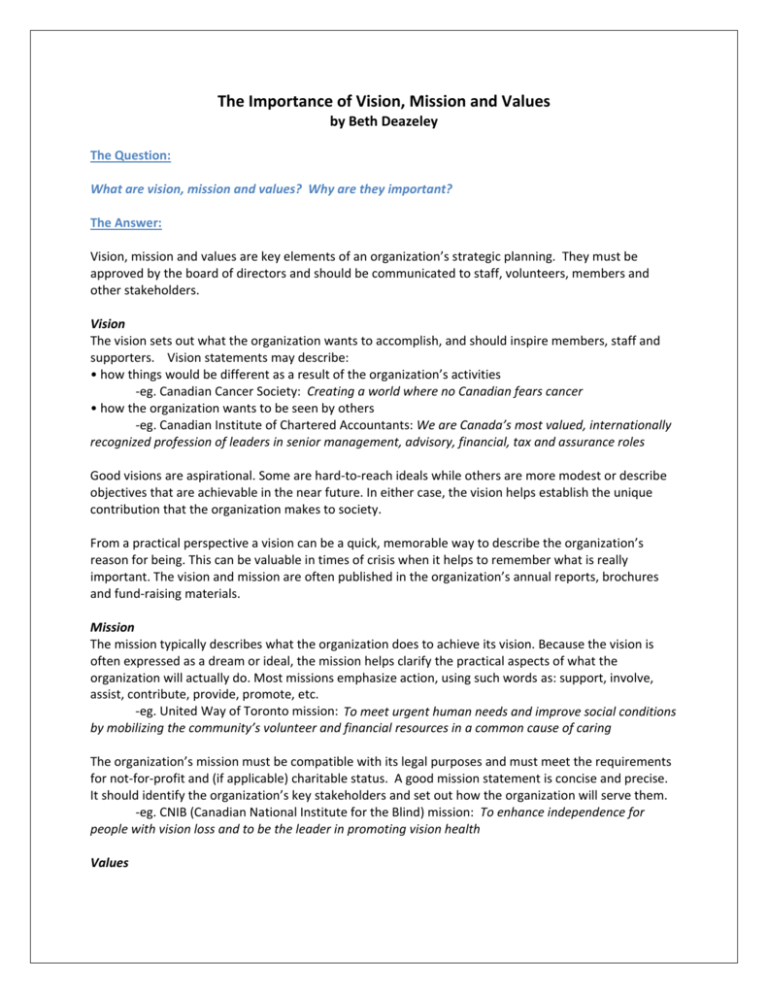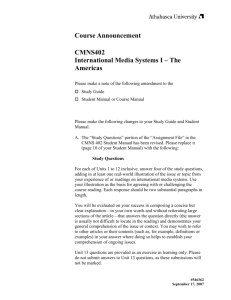Vision, Mission, and Values: Importance & Examples
advertisement

The Importance of Vision, Mission and Values by Beth Deazeley The Question: What are vision, mission and values? Why are they important? The Answer: Vision, mission and values are key elements of an organization’s strategic planning. They must be approved by the board of directors and should be communicated to staff, volunteers, members and other stakeholders. Vision The vision sets out what the organization wants to accomplish, and should inspire members, staff and supporters. Vision statements may describe: • how things would be different as a result of the organization’s activities ‐eg. Canadian Cancer Society: Creating a world where no Canadian fears cancer • how the organization wants to be seen by others ‐eg. Canadian Institute of Chartered Accountants: We are Canada’s most valued, internationally recognized profession of leaders in senior management, advisory, financial, tax and assurance roles Good visions are aspirational. Some are hard‐to‐reach ideals while others are more modest or describe objectives that are achievable in the near future. In either case, the vision helps establish the unique contribution that the organization makes to society. From a practical perspective a vision can be a quick, memorable way to describe the organization’s reason for being. This can be valuable in times of crisis when it helps to remember what is really important. The vision and mission are often published in the organization’s annual reports, brochures and fund‐raising materials. Mission The mission typically describes what the organization does to achieve its vision. Because the vision is often expressed as a dream or ideal, the mission helps clarify the practical aspects of what the organization will actually do. Most missions emphasize action, using such words as: support, involve, assist, contribute, provide, promote, etc. ‐eg. United Way of Toronto mission: To meet urgent human needs and improve social conditions by mobilizing the community’s volunteer and financial resources in a common cause of caring The organization’s mission must be compatible with its legal purposes and must meet the requirements for not‐for‐profit and (if applicable) charitable status. A good mission statement is concise and precise. It should identify the organization’s key stakeholders and set out how the organization will serve them. ‐eg. CNIB (Canadian National Institute for the Blind) mission: To enhance independence for people with vision loss and to be the leader in promoting vision health Values Shared values influence everything an organization does, as well as its relationships with stakeholders and its reputation. Values may be expressed as beliefs, guidelines or rules, and may be set out in a code of conduct. Eg. Canadian Red Cross Values: Integrity and accountability Ethical practices Quality Caring and compassion Client‐focused Responsiveness A statement of values can provide guidance when tough decisions must be made, for example in allocating scarce resources, or when presented with a donation from a group which may be incompatible with the organization’s mission. The values, mission and vision are key elements of a not‐for‐profit organization’s strategic planning process, and will guide the development and delivery of program services and activities. Further information on strategic planning for not‐for‐profit organizations can be found in the CICA publication 20 Questions Directors of Not‐for‐Profit Organizations Should Ask about Strategy and Planning, authored by Hugh Lindsay. Much of this discussion is based on that publication. The content above is provided for general information only and does not constitute legal advice. The views expressed are those of the author and do not necessarily reflect those of the Canadian Institute of Chartered Accountants.











